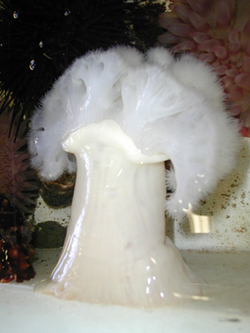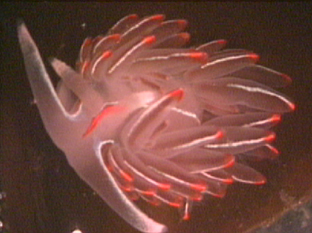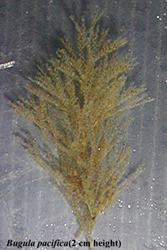

is in the center and is surrounded by tentacles that
contain nematocysts.
Among the filter feeders
are members of the annelid family Serpulidae. These worms are equipped
with special ciliated feeding tentacles that collect detritus and plankton
from the water. These structures have a feathery appearance and are
usually red in color. The collected food particles are transported
into the mouth along ciliary tracts and then enter the digestive tract.
 |
 |
| View
of the oral disk of Metridium senile.The mouth
is in the center and is surrounded by tentacles that contain nematocysts. |
Lateral view of Metridium senile (15cm). |
| Among the raptorial feeders is a nudibranch species called Phidiana crassicornis. This nudibrach is colorful and easily spotted. Phidiana crassicornis feeds on cnidarians, and the fine cerata that cover the dorsal surface are packed with the intact and functional nematocysts of the sea anemones and other cnidarians it feeds on. These nematocysts are used to protect the animal from predators or potential competitors. Recent studies have shown that the aggressive nature of these creatures increases when food is scarce and may even lead to cannibalism (Ricketts et al.,p.140). |
 |

Another species of
nudibranch, Doridella steinbergae, can be found on the surface of
the alga Laminaria saccharina whenever the alga is covered with
the encrusting bryozoan Membranipora membranacea. Doridella
lives and feeds on Membranipora. These nudibranchs are translucent
gray in color and reach a maximum length of 10mm.

Floats are favorable
spots for herbivores such as chitons. One chiton species commonly found
on the floats is Katharina tunicata, which feeds on diatoms and
on the brown and red algae that encrust the floats. Chitons scrape off
food from the substrate using the radula, a unique structure that bears
teeth in transverse rows.
 |
 |
| Dorsal view of Katharina tunicata (5cm). The shell is divided into eight overlapping plates, the main distinguishing feature of chitons. | Partial view of a radula removed from the mouth of a chiton. The radula is a long structure bearing teeth that is used for scraping food from substrates. |